11 tracks – 69:53
Artwork & Photography by Jon Wozencroft
so you might like to note that “In the shape of a flute” is exclusive to the vinyl format of the release, and tracks 1. 3. 4. 5. 6. 11. are exclusive to the CD version
Widely regarded as one of Norwegian electronic music’s most important artists, Biosphere’s [Geir Jenssen] career spans nearly two decades, several albums, lots of remixes, various sound installations, commissions, soundtracks and even the odd Himalayan summit.
You may recognise his work without knowing it, so frequently does it crop up on TV trailers and idents. In the early 1990s he was a pioneer of so-called ‘Ambient Techno’, but since then, he has refined his sound into something more magnetic and enduring.
Dropsonde’ isn’t a soundtrack like the interwoven ‘Substrata’ nor an episodic journey in the way that ‘Autour de la Lune’ is. Here Geir Jenssen is pushing new directions towards the jazz colours of Miles Davis and Jon Hassell, whilst re-invigorating the pulse and projection of his signature sound: a hypnotic combination of pleasure and dread.
The spatial aspects some have dubbed “Arctic sound” but it summons strong feelings, or as Exclaim from Canada put it, “in order to climb higher, you must first go deeper”. Jon Savage adds: “As with all of the Biosphere albums, the music draws you in and makes you want to listen and feel. Jenssen’s work acts on a very emotional level, one that encourages you to drift away into a haze of images and scenes brought to you by the music, where spectacular beauty hides unseen danger. Intense and moving, but comforting and soothing at the same time.”
[A ‘dropsonde’ is a weather reconnaissance device designed to be dropped from an airplane or similar craft at altitude to take telemetry as it falls to the ground. It typically relays information to a computer in the dropping airplane by radio. The fall may be slowed by a parachute. Information collected by a typical dropsonde may include wind speed, temperature, humidity, and atmospheric pressure.]
This is Biosphere’s 5th release for Touch, after “Cirque” [Touch # TO:46, 2000], “Substrata 2” [Touch # TO:50, 2002], “Shenzhou” [Touch # TO:55], and “Autour de la Lune” [Touch # TO:62, 2004]. He has also contributed to various Touch compilations, including “Spire – Organ Music, Past, Present & Future” [Touch # Tone 20, 2004), and more recently to the Storr walk on Skye, Scotland, a guided tour through stunning landscape accompanied by illuminations and sound recordings.
Track list:
1. Dissolving Clouds
2. Birds Fly By Flapping their Wings
3. Warmed By the Drift
4. In Triple Time
5. From a Solid To a Liquid
6. Arafura
7. Fall In, Fall Out
8. Daphnis 26
9. Altostratus
10. Sherbrooke
11. People Are Friends
Reviews:
failme.net (UK):
Having just had the pleasure of meeting the man himself when I was his DJ support at some industry shindig in Central London the other week. I’d decided to backtrack and revisit this, his last album for Touch. Those first few albums for R&S Records were deceptively dubbed ‘ambient’, but I’d found them to be anything but. More propulsive statements in isolated techno.
In short ‘Dropsonde’ is pretty amazing. The opening snow drift of ‘Dissolving Clouds’ lends an abstract, disengaged feel that’s reminiscent of earlier work before the shuffling jazz drums of ‘Birds Fly By Flapping Their Wings’ sets the tone for the rest of the album. And despite his meteorological association with winter, I found this to be a warm, accessible, beautifully presented and inviting piece of contemporary electronic music. [Sheikh Ahmed]
Sonomu (Sweden):
Dropsonde, the latest album by the most interesting and constantly evolving ambient artist of them all, announces itself with a three-note chime, not unlike the station identification used by the NBC television network. Biosphere then builds an entire track out of it by bending, stretching, delaying and quietly embroidering in between this trio of notes. It´s that simple, and yet not at all.
In this newest work, Biosphere returns to rhythmic music, but not of the sort that characterized his early, classic, techno-influenced albums, like Microgravity and Patashnik. Instead, he borrows an idea already broached by a handful of other artists – loaning rhythm tracks from “classic jazz” – and makes it his own by encompassing it in his signature otherwordly sound.
Appropriately enough, a “dropsonde” is a device which relays organic information to a computer. And is this not what Biosphere has been doing throughout his career, somehow relaying his impressions of the world of around us electronically?
All other considerations aside, the litmus test is how good the music is to listen to, and it is just gorgeous. “Warmed by the Drift” is one of the most assured and sensual pieces Biosphere has ever committed to record. Surrounding it are ten other pieces over a generous running time of seventy minutes, each one a small masterpiece, closing with the weightless drift of the elongated “People Are Friends”.
A highlight of the year in music as well as a highlight in the œvre of Biosphere. And as always, housed in a typically beautifully crafted Touch digipak. [Stephen Fruitman]
Grooves (USA):
On his eighth album, Biosphere’s Geir Jenssen has done something not many would have expected of this ambient soundscape guru: He’s reinvented his sound. Over the course of a career now spanning well over a decade, Biosphere has dependably crafted minimalist, drifting music that pulses serenely on the edges of consciousness, incorporating rhythmic loops almost subliminally into his fog-like constructions. On albums like his epic Substrata and its sublime follow-up Shenzhou, which incorporated hazy orchestral samples into the mix, this formula worked beautifully. But on his last album, Autour de la Lune, Jenssen’s longtime formula abandoned him, and his subtle music drifted across the very fine line into boredom and emptiness.
Perhaps realizing this, Biosphere has made Dropsonde a very different effort indeed. In terms of surface sounds, this new disc is not an entirely drastic departure – there’s still the same attention to melodic loops and subtly layered sounds – but Jenssen has also incorporated more traditional rhythms that shake off the sleepy stupor of Autour. On “Birds Fly by Flapping Their Wings”, this new sound is shown off early as jazzy drums and cymbal splashes drive steadily atop the more familiar ethereal shimmer. “In Triple Time” explores similar ground, but even more exuberantly, with rapid drumming and upbeat melodic loops bubbling away in the background.
Elsewhere, things are more familiar, and not every track is dominated by Jenssen’s nods to rhythm. “From a Solid to a Liquid” is a lovely, haunting piece that builds a warm, slowly percolating melody atop the crackling hiss of field recordings, and it’s very much in the spirit of Substrata. On “Fall In Fall Out”, Jenssen strikes a middle ground between old and new for the album’s most compelling track. Crackling vinyl noises and digital glitches glide across a dim bed of chopped-up melodic fragments, with drums blending in more than they do on other tracks.
Dropsonde is an interesting, if not entirely successful, new direction for Biosphere. While Jenssen never really approaches the grandeur or elegance of his best work, it’s nevertheless encouraging to see this talented artist rethinking his approach. [Ed Howard]
All Music Guide (USA):
Geir Jenssen has moved toward something new on Dropsonde — finally on CD after having been issued on LP some months previously. The CD version contains more music, about 25 minutes more. It’s the sound and arrangement of this one that grabs the listener’s attention quietly and gently, but nonetheless insistently. First, the definition that provides a telltale hint of the album’s sound: a “dropsonde” is a radiosonde, dropped by parachute from an aircraft, to obtain soundings of the atmosphere below. The principle applies here in spades. The opening moments of Dropsonde’s second track, “Birds Fly by Flapping Their Wings,” are familiar to all of Jenssen’s ambient music: a gray sonic wash of random elements that could be weather, water, etc., float in from the margins. A synth plays a quiet drone underneath for a few moments. About 40 seconds in, a drum loop that could be from Tony Williams on a Miles Davis record slips in. It’s constant, it never moves, but it shimmers just right for the two-chord keyboard sequence to hover above while the other sounds and keyboards subtly move in ghostly fashion through the middle and underneath. The rhythm is hypnotic, but the piece is far from static — it just slowly draws you in. There is emotion in it; it feels good; it feels meditative but alive. The piece gradually strips away everything but the sounds the listener heard coming in. The Miles reference isn’t a mistake; in a number of tracks here, Jenssen touches upon the jazz musician’s colors, modes, tensions, and edgelessness. It’s the Miles of the second quintet and the Miles of In a Silent Way, where mode falls away and the smaller, repetitive vamp leads the way in. Check “Triple Time,” “Fall in, Fall Out” (with its shimmering, authoritative military-style loop), and “Arafura,” which is perhaps the finest articulation of Jenssen’s method; it’s spare and beautiful yet lush, with slowly unfolding mystery. Other tracks here, such as “Daphnis 26,” offer a more forbidding ambient tone before the loops kick in and send the listener to an edge that never quite materializes. “Altostratus” and the opener, “Dissolving Clouds,” are far more minimal, almost random in their computer tones and tunnels. The blissed-out “Sherbrooke” is a minor masterpiece, taking the ambient form into new directions with its utilization of sonic loops that become rhythmic statements under the radar. The album closes with the whispering quietude of “People Are Friendly,” with keyboards swelling gently in hushed tones as voices appear and disappear through the mix for the entire ten and a half minutes before the album itself, like the track, disappears into silence, echoing memorably but indescribably in the mind of the listener. Jenssen only records when he has something new to say; he’s said it here.
Urb (USA):

XLR8R (USA):
It was inevitable that Norwegian ambient minimalist Geir Jenssen (Biosphere) would explore the microfibers of jazz. After a dozen years of pioneering quiet, cold-filtered electronic music that invoked his arctic surroundings, Jenssen now applies his techniques to ECM-style sounds (think Keith Jarrett, Ketil Bjørnstad, etc.). Unlike his jazz-noodling countrymen, Jenssen sacrifies none of his contemplative ambient climates on ‘dropsonde’, his fifth release for England’s austere [! – ed.] Touch label. Whereas Jenssen’s attempt to “bliss out” classical music samples and loops on ’02’s ‘Shenzhou’ proved lacklustre, the jazz snippets on “In Triple Time” and “Fall In, Fall Out” add tension to a recording that will leave you mesmerized for repeated listenings. [Tomas Palermo]
Almost Cool (USA):
Geir Jenssen has been creating ambient music under the name Biosphere for over fifteen years now. He’s released nearly twenty albums worth of material in that time, both on his own and in collaborations with everyone from the Higher Intelligence Agency (on the great Polar Frequencies) to Deathprod. In that time, his work has plumbed such a signature sound that he’s been coined as having originated the “Arctic Sound.” Over the course of the past couple years (especially on his releases for the Touch label), his work has reached a very high level of maturation and development. Maturation isn’t probably quite the right word for someone who has been creating music for so long, but his past several releases have burst forth with such singular, refined (yet unique) visions that although the variety of his early work like Substrata is made to sound like sketches in places. His Shenzou is an all-enveloping soup of strings and murky nocturnal pulses while his most recent effort Autour De La Lune pushed off into deep space with icy tones and much less of a focus on melody. In that same way, Dropsonde finds Jenssen moving in another singular direction for the course of an entire album, and the result is again highly refined and enjoyable.
Jan Jelinek and other artists have been dipping their toes into jazz music for some time now, but you haven’t heard anyone melt the pieces of the genre down to their base elements and reconstruct them in the way that Jenssen has here. After the short opening track of “Dissolving Clouds,” the album moves forth with warm resonated melodies and shuffling snares in “Birds Fly By Flapping Their Wings.” “In Triple Time” again finds some jazz percussion loops shuffling while filtered and bent horns moan like whale calls in a bay.
I mentioned Jelinek above, and in places on Dropsonde, there’s definitely a resemblance. “Fall In Fall Out” is all stuttering upright bass loops and hissy vinyl static while a martial snare keeps time. Most of the other times, though, the album reaches for those deep, dark places that Biosphere seems to know how to massage best. “Warmed By The Drift” calls to mind the title as layer upon layer of dense washes cover your ear like blowing snow while “Daphnis 26” chugs along with deep, rumbling beats and multiple layers of stuttering loops. As with his other excursions into different styles, Jenssen still maintains an almost signature sound on most of the tracks, and because of that very reason, you will definitely enjoy this album if you like his other work. I’ll admit that I’m a sucker for this type of all-enveloping ambient music, and Jenssen seems to know just which buttons of mine to push.
rating: 7.75
LA Alternative (USA):
Back from his lonesome astral roaming on 2004’s Autour de la Lune, Norway’s Biosphere (AKA Geir Jenssen) seems still affected by that oxygen-deprived, zero gravity excursion. Although a version of it was already released on vinyl late last year, Dropsonde is now available on CD with new artwork (blurry sunspots in place of an ethereal cloud cover), six new songs and one track missing (the LP’s closing “In the Shape of a Flute”). The sine wave purism of Autour all spent, Jenssen throws in some uncharacteristically skittering breaks for the hi-speed hypnosis of “In Triple Time,” steely rhythms pulsing and recombining all over the iridescent “Arafura,” a hissy march holding the worn grooves of “Fall In, Fall Out” together and asthma-attack beats for “Daphnis 26.” But throughout Dropsonde, Jenssen remains blissed out and gone, less interested in thump and boom than texture and space; hewing to Brian Eno’s proclamation, back when the producer-performer was building an oeuvre of “ambient” long-players in the late 1970s, of an “environmental” music that is “to be experienced from the inside.” Dropsonde looks back to that analog moment of minimalist experimentation while also swimming ahead through glistening digital tides. “Sherbrooke” recalls the ecstatic fuzz and melodious glide of Loveless though played through shiny circuits instead of Marshall stacks while closer “People Are Friends” is a reminder that Jenssen was trafficking spectral tones and ghost voices long before Boards of Canada. A dizzying canvas of weightless loops, Dropsonde proves this veteran architect of twilight soundscapes remains a master of the machine-addled sublime.
Straight No Chaser (UK):

Word (UK):
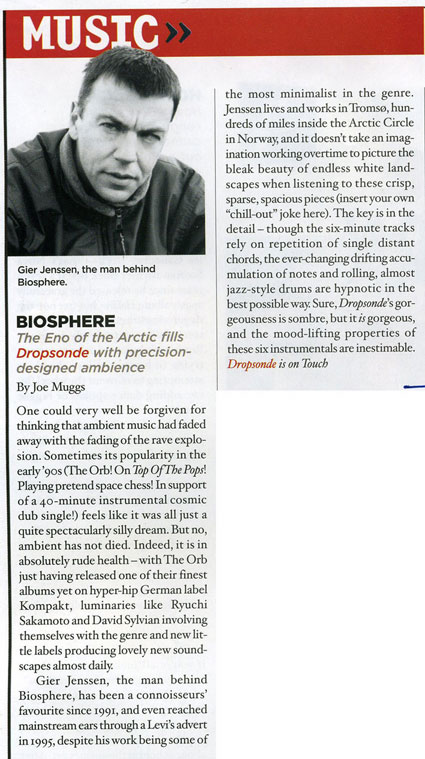
Rock Sound (UK):

Future Music (UK):

Indieworkshop (USA):
There are few musicians or composers that can hypnotize me the way that Geir Jenssen does. His subtle manipulations of patterns and soundwaves will have me staring at my speakers for hours on end. Almost instantaneously my eyes glaze over and I sink deep into my couch. The rhythmic pulses wash over me and surround my head like a warm scarf. Like the cover art, I’m aimlessly lost in a wispy sky. I’m back on the hill behind my boyhood home, looking up at the clouds while I waste my summers away. And while that all sounds over dramatic and more than a tad pretentious, if you have sat and listened to any one of Jenssen’s recordings as Biosphere those words will ring true. It’s sonic therapy; music’s answer to acupuncture and meditation.
Where his last album, Autour de la Lune, was mainly an exercise in the lower registers of the sonic realm, Dropsonde is brighter and more immediately engaging listen. Instead of feeling the steady grown and emptiness of space, Jenssen has tapped into a sound almost reminiscent of 90’s drone kings Seefeel. It’s very much more looped based, with almost every song focused around one centralized “riff” as it were. But it’s not just a slow manipulation of that one loop, he incorporates different textures and sounds (non-looped) through out, giving each track a personality and a degree of interest well above most drone based music.
The songs have that certain chilled out feel, but it’s not as desolate as Autour… I wouldn’t go as far as to say that this time around Jenssen has gone poppy, but the heavy weight of his past work has somewhat been lifted. It’s an album that begs for your attention while it floats you off into the sky. Everything just floats out of you, anger-tension-worry-energy, and you are left to bob up and down with the slow ebb and flow of his sonic waves. Trance has never been so interesting and peaceful. [Jake Haselman]
Intuitive Music (Spain):
In top 20 albums of 2005
In “Dropsonde” Biosphere is pushing new directions towards the jazz colours of Miles Davis and Jon Hassell, whilst re-invigorating the pulse and projection of his signature sound: a hypnotic combination of pleasure and dread. A perfect invitation to new paths in electronic fusion music for the 21st century.
The Big Chill (UK):
Here comes another icebreaker from Geir Jenssen’s secret Tromso headquarters.
“A ‘dropsonde’ is a weather reconnaissance device designed to be dropped from an airplane or similar craft at altitude to take telemetry as it falls to the ground. It typically relays information to a computer in the host plane by radio. A parachute may slow the fall. Information collected by a typical dropsonde may include wind speed, temperature, humidity, and atmospheric pressure”.
The notion of this small, compact and highly mobile unit of super quality technical kit listening to the environment, is oddly metaphorical for the Biosphere programme itself. Music that is as much about the world about us as it is about top end digital production layering. And as always, the fantastic quiddity of the work.
The six tracks on this album are currently only available in vinyl format; the CD will follow in November [now early 2006 – ed.]. The music represents a change from the impressionist washes of Shenzhou and Autour La Lune but it is unmistakeably the work of Biosphere. The territory is confirmed from the opening bars.
The widescreen aspect of the sound is firmly present but there is now a shuffling and insistent feel that has been absent of late and is much welcome on its return. The beat is back, as “Birds Fly By Flapping Their Wings” heralds an urgent drum pattern under a floating sky that is echoed in the snare drum matrix that tags down “Fall in, Fall Out”. .
“Altostratus” is another floater, suspended in its own animation and creating the three dimensional space in which the Biosphere sound collage defines itself best. The stand out cut, however, is the majestic “Sherbrooke” which is a rising, building anthemic humdinger capturing light and space and adding almost Copeland like brush strokes which ever so faintly suggest “Shaker Leaps”.
As in the other cuts these sprung rhythms underpin and add to the mix bringing an element of excitement to the tracks and making this a landmark record for the artist. This is a wonderful piece of work and one of the most organic sounding electronic albums to emerge so far this year. [Alan James]
Milk Factory (UK):
Biosphere’s Geir Jenssen has spent the last fifteen years redefining the boundaries of electronic-based ambient music. Although his early solo work as Bleep was largely club orientated, his first output as Biosphere, the 1993 album Microgravity gave the first signs of Jenssen’s future musical direction. Since, his work has taken many shapes, from records and installations, often involving landscapes, to live performances. Since his 1997 album Substrata, Jenssen’s records have increasingly become more introverted and distant, with last year’s Autour De La Lune, a project based around the Jules Verne book of the same name, being by far his most austere work.
With Dropsonde, Jenssen returns to more hospitable territories. Abandoning drone-like moods for richer soundscapes, Jenssen applies jazz-infused beat patterns and tones over sumptuous loops. The album opens in typical Biosphere territory, with a dense formation reminiscent of Substrata or Polar Sequences, but, just a minute in, a relentless bip-bop-flavoured beat kicks this comfortable setting in the balls and sends the composition spinning in a totally new dimension. While this combination originally appears rather linear, soon, scattered over a surprisingly clear melodic line, incredibly fine sonic details materialise, each one impacting on the listener’s perception by adding some relief to the landscape.
Jenssen applies similar principles to four of the five remaining tracks, yet, he finds a different way to cast his sounds and shape the mood of a piece with each new track. Dropsonde is a far cry from the impressionist touches of Shenzou or the barren backdrops of Autour De La Lune. Here, Jenssen embraces rich sonic formations, engages groove and applies lavish brushes and textures all the way through. The only composition to deviate slightly from this template is the wonderfully smooth Altostratus. Here, Jenssen revives for a moment the mood of Patashnik by sending out electronic pulses above a sombre cloud of electronic soundwaves.
It is no coincidence that this particular album is originally being released on vinyl. While Jenssen’s various efforts of the last few years suited the clinical sound of CDs, Dropsonde gains in depth and texture with additional crackles and statics, while Jenssen’s sound palette also contributes to giving this album a raw organic feel. Adding to the mood is the album length itself. Clocking at just under forty minutes, Dropsonde is Biosphere’s briefest record, yet still allows for vast sonic spaces to develop fully while remaining entirely consistent, making it Jenssen’s most accomplished record to date. [4.8/5]
Ananana (Portugal):
Poucos como Geir Jenssen, aka Biosphere, foram tão bem sucedidos em continuar os preceitos do ambientalismo na electrónica, colocando em circulação obras que chegaram mesmo a ultrapassar em conseguimento e pertinência as que fundaram o género, da autoria do nem sempre feliz Brian Eno. Ainda que continuando a sua dedicação ao paisagismo sonoro, é outra, no entanto, a agenda do norueguês no novo “Dropsonde”. Depois do austero e brilhante “Autour de la Lune”, a sua homenagem ao romance de Jules Verne com o mesmo título, ei-lo que volta ao domínio do “beat” que marcou os seus inícios (“Cirque” é o disco com que inevitavelmente é comparado), com a inclusão de ritmos de bateria provenientes do jazz mais “groovy”. Ao que parece, trata-se de “samples” e todas as suspeitas levam a acreditar que as fontes foram os velhos LPs da Blue Note, mas nenhuma indicação é dada a esse respeito na ficha técnica. O simples facto é suficiente para alterar de modo substancial os parâmetros em que o projecto Biosphere se tem movimentado. Se de disco para disco o ouvimos em busca da máxima depuração, a introdução de elementos percussivos leva-o agora a optar por uma maior riqueza tanto ao nível das texturas como da própria composição. Daí até uma comparação com os modalismos eléctricos de Miles Davis ou Jon Hassell vai uma grande distância, mas a alusão tem sido feita por alguma crítica. De facto, nem Hassell nem muito menos Davis cuidaram de forma tão propositada o “mood” das suas respectivas músicas – nesse aspecto, uma boa parte das preocupações da fórmula Biosphere ainda vai para a sustentação de atmosferas e estados de espírito.
Biosphere “Warmed By The Drift” – And this, friends, is probably the best track of the bunch. No beats, no rhythm, no melody to speak of, just transcendent aural beauty. It’s the kind of music that constructs soothing images in the mind’s eye–which for me were of a deceptively desolate desert landscape at dawn, as viewed from the perspective of a driver who’s been making an all-night trek. She’s been witness to the gradual brightening of the sky, watching the shadows appear and slowly start to edge across the distant bluffs on the horizon. It’s been a long and lonely stretch, with nothing on the radio but preachers and country music to keep her company, but the miles have ticked down to double digits and home (and breakfast) isn’t far away now. The stillness and peace of the surrounding landscape as it warms to another day is awesome, overwhelming, stunningly beautiful.
Moebius Rex blog:
Biosphere “Warmed By The Drift” – And this, friends, is probably the best track of the bunch. No beats, no rhythm, no melody to speak of, just transcendent aural beauty. It’s the kind of music that constructs soothing images in the mind’s eye – which for me were of a deceptively desolate desert landscape at dawn, as viewed from the perspective of a driver who’s been making an all-night trek. She’s been witness to the gradual brightening of the sky, watching the shadows appear and slowly start to edge across the distant bluffs on the horizon. It’s been a long and lonely stretch, with nothing on the radio but preachers and country music to keep her company, but the miles have ticked down to double digits and home (and breakfast) isn’t far away now. The stillness and peace of the surrounding landscape as it warms to another day is awesome, overwhelming, stunningly beautiful.
It’s funny that that should pop into my head, because Biosphere is usually associated with the frosty fjords and snowbound forests of Norway, where Geir Jennsson (the man behind the music) makes his home. But my mind works from its own experience: I’ve not logged much time in the permafrosted parts of the world, but I did spend formative years of my life in southwestern Arizona, and, later, made several drives through Nevada and down I-5 in California. You make do with what you have. The lovely thing about Dropsonde, Biosphere’s forthcoming CD release, is that it works with you to construct your own vision of peace and tranquility. Very highly recommended, especially for those of you dealing with stressful times (ah, but who isn’t?).
plan b (UK):
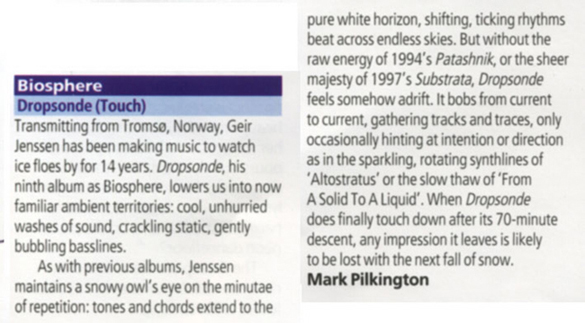
Echoes Online (Germany):
Mit dem gut zugänglichen 94er Ambientwerk „Patashnik“ und dem darauf enthaltenen Hit „Novelty Waves“ hatte die Musik von Geir Jensen (Biosphere) zuletzt nur noch ganz wenig bis gar nichts zu tun. Entsprechend selten höre ich z. B. auch das letzte Album „Autour de la Lune“. Das soll nicht heißen, dass ich dieses Werk nicht sonderlich mag, doch irgendwie führt mich meine Stimmung nur selten an einen Platz, der sich anfühlt, wie ein Spaziergang tief unten im einsamen Ozean – einem Ort, den die Sonnenstrahlen nicht mehr erreichen. Weniger blumig formuliert, fehlt mir an den „normalen“ Tagen womöglich einfach die Ruhe, sich dieser monoton anmutenden Musik hinzugeben. Das neue und wieder auf Touch erscheinende Album „Dropsonde“ enthält zwar auch die eher experimentellen Klänge der letzten Arbeiten, leugnet aber zudem nicht die musikalischen Anfänge aus dem Biosphere-Katalog. Mit „Dropsonde“ schlägt Jensen nun eine Brücke zwischen diesen beiden Polen. Während sich auf einem Titel wie „From A Solid To A Liquid“ eine stille Atmosphäre ausbreiten darf, treiben im Jazz geerdete Percussions Stücke wie „Birds Fly By Flapping Their Wings“ und „Arafura“ voran. Warm und poppig anmutende Soundflächen ergänzen diesmal wieder die tief frequenten und druckvollen Bässe. Geir Jensen setzt seine musikalischen Ausdrucksformen wohlbedacht ein und vermengt sie zu einem abwechslungsreichen Gesamtwerk. Vielleicht wirkt „Dropsonde“ deshalb für mich sogar wie ein Best-Of-Album von Biosphere. Zum Kauf dieses Albums wird also dringend geraten. Nicht nur wegen des gewohnt tollen Cover-Artworks von Jon Wozencroft.
Benzinemag (France):
Pour ceux qui s’intéressent depuis plusieurs années aux musiques électroniques, et notamment à celles qui vont un peu plus loin que les autres en terme de personnalité et d’originalité, nul doute que le nom de Biosphere a une signification toute particulière. Depuis 1990, le norvégien Geir Jenssen, à la tête du projet, s’ingénie à créer des musiques électroniques ambient, follement envoûtantes et très évocatrices, composées la plupart du temps de boucles superposées et arrangées de telle manière à produire sur l’auditeur une sorte d’hypnose, de doux envoûtement.
Ici l’on découvre une nouvelle facette du talent de ce producteur qui nous convie une fois encore dans son immense espace sonore, dans sa (Bio)sphere musicale, de laquelle se dégagent de bien belles choses ; à commencer par ces ambiances tranquilles très réussies que l’on découvre au fil des titres.
Et sans doute depuis Cinematic Orchestra, les boucles jazz n’avaient pas tourné aussi bien qu’ici. Superposées à des nappes, à des bruits divers évoquant les trains, les voyages, l’espace, etc, ces boucles se révèlent très cuivrées (surtout sur les titres Birds Fly By Flapping Their Wings In, Triple Time et Fall In Fall Out) et donnent une chaleur étonnante à un ensemble qui reste pourtant dans l’ensemble très froid… un peu comme si une boite de jazz avait ouvert ses portes sur la banquise.
Malgré tout, aussi dépouillés soient-il, ces titres n’en restent pas moins saisissants de beauté et de force. Et derrière cette apparente austérité, ce coté clinique indéniable, se cache une richesse musicale qu’il ne faudrait tout de même pas tarder à découvrir.
A l’origine paru uniquement en vinyle, Dropsonde est réédité au format cd avec 6 titres en plus. [Richard Benoît]
ondefix.net (France):
Pour ceux qui s’intéressent depuis plusieurs années aux musiques électroniques, et notamment à celles qui vont un peu plus loin que les autres en terme de personnalité et d’originalité, nul doute que le nom de Biosphere a une signification toute particulière. Depuis 1990, le norvégien Geir Jenssen, à la tête du projet, s’ingénie à créer des musiques électroniques ambient, follement envoûtantes et très évocatrices, composées la plupart du temps de boucles superposées et arrangées de telle manière à produire sur l’auditeur une sorte d’hypnose, de doux envoûtement.
Ici l’on découvre une nouvelle facette du talent de ce producteur qui nous convie une fois encore dans son immense espace sonore, dans sa (Bio)sphere musicale, de laquelle se dégagent de bien belles choses ; à commencer par ces ambiances tranquilles très réussies que l’on découvre au fil des titres.
Et sans doute depuis Cinematic Orchestra, les boucles jazz n’avaient pas tourné aussi bien qu’ici. Superposées à des nappes, à des bruits divers évoquant les trains, les voyages, l’espace, etc, ces boucles se révèlent très cuivrées (surtout sur les titres Birds Fly By Flapping Their Wings In, Triple Time et Fall In Fall Out) et donnent une chaleur étonnante à un ensemble qui reste pourtant dans l’ensemble très froid… un peu comme si une boite de jazz avait ouvert ses portes sur la banquise.
Malgré tout, aussi dépouillés soient-il, ces titres n’en restent pas moins saisissants de beauté et de force. Et derrière cette apparente austérité, ce coté clinique indéniable, se cache une richesse musicale qu’il ne faudrait tout de même pas tarder à découvrir.
A l’origine paru uniquement en vinyle, Dropsonde est réédité au format cd avec 6 titres en plus. (9.0) [Richard Benoît]
iDJ (UK):
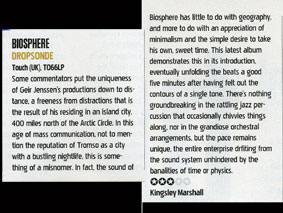
de:bug (Germany):
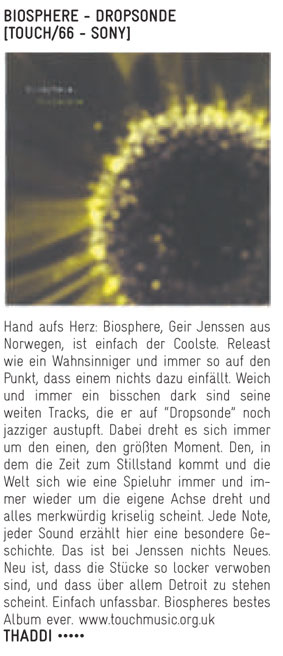
Fareastudio (USA):
Before starting his musical career, Japanese noise pioneer KK Null studied the jarring dance theatre known as Butoh. Characterized by their white-painted bodies and grotesque beauty, Butoh dancers are said to concentrate intently on an internal image and move in response to this inner vision. Audiences are not expected to know what the dancer is seeing, but to construct their own story for the dance.
Null’s recent collaboration with Chris Watson (Cabaret Voltaire) and z’ev has a similar Rorschach effect. Like Toshiya Tsunoda’s latest, Number One juxtaposes the natural and synthetic. But while Tsunoda practices minimalism, this trio creates thick soundscapes of crickets, thunder, elephants and manmade sounds that hum, grind and resonate. This is sound at its most visual, and every pair of ears will see something different. [Mack Hagoo]
Music Magazine (Japan):
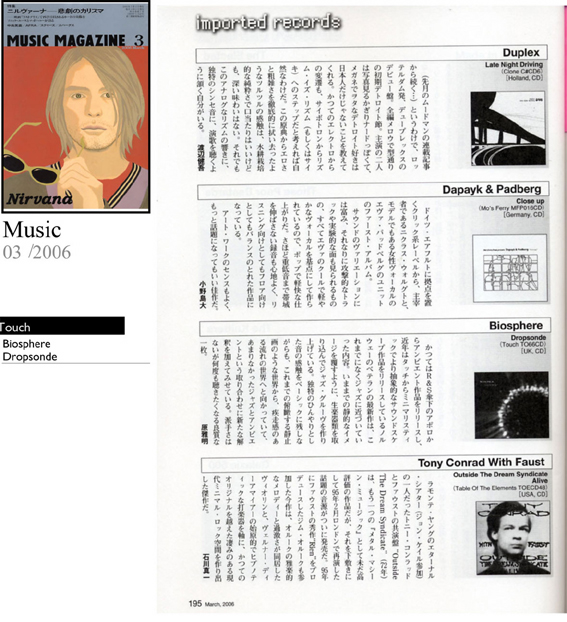
Laut (Germany):
Es gibt sie, die Alben, in deren Sound man einfach nur eintauchen möchte. Getragen von angenehmen Klängen und Effekten nahe am geräuschlichen Nichts, bieten sie einem die Möglichkeit, in ein Paralleluniversum einzusteigen, das sich vom hektischen Wumms und der Aufgeregtheit des medialen Alltags abhebt. Nichts schreit einem ins Gesicht, da ist genügend Raum, um die eigenen Gedanken im Gleichklang mit der Musik schweben zu lassen. Nein, hier geht es nicht um drogengeschwängerte Sounds vom Mars, die erst mittels Pilz- oder LSD-Flash ihre Wirkung entfalten. Geir Jenssen aka Biospere fungiert als Geburtshelfer für Kollagen aus seinem Klanglabor, die scheinbar wie von selbst den Weg in die Welt finden. Anders sind die wunderbaren tonalen Skulpturen kaum zu erklären.
Alles beginnt mit einer simplen Tonfolge, die auch eine Durchsage auf einem Bahnsteig ankündigen könnte. Begleitet von einem merkwürdigen Hintergrundrauschen flirren viereinhalb Minuten rhythmisch unregelmäßig Töne hin und her. Bis dann mit “Dissolving Clouds” tatsächlich der Himmel aufzieht und der Blick wieder klarer wird. Hier kommt wieder der erwähnte Bahnsteig in den Sinn, denn auf einmal zieht das Tempo sanft an. Eine Geräuschkulisse wie ein fahrender Zug rattert voran, Keyboardflächen (die auch als solche erkennbar sind) greifen sich ihren Raum, und auf einmal ist er da, der Jazz. Sanft hoppelnde Hihat-Sounds und Besen-Samples sind mit das Letzte, was man von einer Biosphere-Platte erwarten konnte, nach all den Jahren, in denen Jenssen sanft dem vertonten Nichts entgegen schwebte.
Und dann das. Aber egal, da haben wir sie wieder, diese nordische Kühle, gepaart mit organischer, menschlicher Wärme. Das erzeugt eine Stimmung, gerade so, als genieße man in einer absolut lebensfeindlichen, eisigen Umgebung mit seinem besten Freund ein Gläschen Rotwein, in die wärmsten Pullis gemümmelt, die man sich nur vorstellen kann. Den stringenten Faden führt Jenssen weiter, steigert die Geschwindigkeit nochmals, flankiert von allerlei verfremdeten Sprachsamples. Die Strömung, die sein Sound hinterlässt, wärmt in der Tat so, wie es der Trackname verlauten lässt.
Im Vergleich zu den manchmal bedrückenden, tiefschwarzen Sound-Sphären der früheren Biosphere-Ära (“Microgravity”, “Patashnik”), klingt “Dropsonde” an manchen stellen richtiggehend heiter. Der Frühling kann kommen, selbst wenn das Album auf Vinyl schon einige Monate auf dem Buckel hat. Die Fraktion der CD-Hörer darf sich das neueste Opus Dei aus dem Hause Jenssen ganz unbesorgt in den Player schieben und zigmal wieder von vorne hören. Es gibt genug zu entdecken.
Ikonenmagazine (Germany):
Der norwegische Musiker Geir Jenssen hat mit seinem Projekt Biosphere seit Jahren eine eigene Liga der Ambientmusik eröffnet: Immer weiter treibt er seine mitunter kühlen, düsteren, aber stets originellen Erkundungen der nördlichen Landschaft. “Dropsonde” – benannt nach Wettersonden, die in der äußeren Hemisphäre abgeworfen werden – erringt mit leichter Hand jazzige Sphären, ohne den faszinierenden Soundscape-Charakter zu verraten, der Stücke wie”Novelty Waves” zu weltweiten Hits werden ließ. Bediente sich Jenssen früher oft technoider Strukturen, vertraut er seit “Substrata” auch auf minimalistische Flächen, die sich nur langsam aus der Firnis lösen.
Anders als seine Kollegen vom erdigen Darkambient-Fach tendieren die Biosphere-Kompositionen nicht zur Erstarrung. Sie befreien sich schichtweise von ihrer Kruste, um in luftigere Höhen aufzubrechen, zu denen sie von flirrenden Miles-Davis-Beats getragen werden. Doch hinter dieser Leichtigkeit lauert erneut das Unbekannte. Erst mehrere Dimensionen müssen erschlossen werden, um die volle Tiefe dieses Werkes zu offenbaren. Stimmen wurden laut, die hier das reifste und aufregendste Album von Biosphere vermuten, und tatsächlich suchen die 11 kubistischen Klangskulpturen ihresgleichen – “Dropsonde” lullt ein, spornt an, irritiert und verstört, wie man es von einer Ambientsinfonie nur erwarten kann. Die Titel bleiben dabei assoziativ und rätselhaft: “Warmed by the Drift”, “From a Solid to a Liquid”, “Daphnis 26”, “Sheerbroke” usw. Die stilvolle Umschlaggestaltung bietet dazu Detailaufnahmen von Blüten in verfremdeten Farben.
Wer glaubt, Ambientmusik habe mit Brian Eno bereits vor 20 Jahren ihre Möglichkeiten erschöpft, sollte sich dringend “Dropsonde” besorgen, ein eigenes Kapitel in der Geschichte des Klangkunstprojekts Biosphere wie auch der ambienten elektronischen Musik allgemein – ein Meisterwerk. [Marcus Stiglegger]
Indieworkshop (USA):
It might be a bad idea to release two different versions of the same album on two different formats (and only a few months apart) for most artists, but something tells me that fans of Biosphere won’t care. Geir Jenssen, the Norwegian father of ambient techno, has the pull and the following to do just that. While the LP for Dropsonde came out late last year, it boasted a mere six tracks of his masterful sonic waves. And while it’s a great LP, you can never have enough of these hypnotic loops at your disposal. So adding five more tracks, the CD version has enough drone to put you into a comfortable two week coma.
The five extra tracks go a long way to creating a totally different feel for this alternative version to the LP. But even with the new songs and longer format, it’s hard for me to come up with a new angle to take on this release. Don’t get me wrong, I think it’s great and might even be of a more complete listen than the LP version. But I feel like I’ve said all that I need to say when I tackled the LP.
But maybe you missed my review earlier this year, so lets recap. Dropsonde is the aural equivalent to floating in a sensory deprivation tank. The music is so bleak and minimal that when it starts you could easily miss that it was playing at all. But slowly it seeps into you, it quietly creeps under your skin. The slightly altering loops will dig deep into your vital organs and start tugging ever so softly at your mind. It happens so subtly that you don’t even realize it, but you’ve become completely engulfed in Jenssen’s world. Your eyes will softly roll into the back of your head and astral projection won’t seem like a far-fetched idea.
With almost twice the amount of tracks, and over twice the length, the CD version of Dropsonde might even be a better listening experience than the LP. Down tempo DJ’s have probably bought up all the LP versions, so I’m guessing the CD version might be the only one you will be able to find these days. But if you are into chilling out and putting on something to zone out to you won’t regret picking this up for one minute. [Jake Haselman]
Tinymixtapes (USA):
Though it is being touted as an effort to incorporate elements of modal jazz with the signature Biosphere “arctic sound,” Dropsonde, put simply, is merely another strong release from Norway’s Geir Jenssen and is very much in the same vein as previous releases, albeit with jazzier, slightly noirish overtones. Much of the album, which was recently issued on CD after having been previously released on vinyl, has a vaguely jazz-tinged flavor, but beneath its downtempo trappings, Dropsonde shows Biosphere remaining close to its ambient techno roots—perhaps even making something of a return to them after the starkness and minimalist austerity of recent Biosphere efforts.
The first half of the album alternates between beatless, Eno-esque ambience and evocative, jazzier soundscapes featuring beats that reveal their vinyl source material. Much of Dropsonde sounds influenced, to some degree, by the Radiohead b-sides of the Amnesiac era. Like the Radiohead tracks, Dropsonde shows Jenssen not so much attempting to create an album of modal jazz per se, but rather utilizing jazz elements to infuse these tracks with a moody, smoky atmosphere. Dropsonde, like previous Biosphere releases, is certainly characteristic of the artist’s signature downbeat and trancelike sound, but the addition of sampled live instrumentation and gentle, brushed drum loops adds a warm, autumnal hue to these pieces. Like his peers Thomas Köner and Jan Jelinek, Jenssen makes liberal use of needle noise and vinyl static to add a pleasant warmth to the proceedings that helps to offset their frigid, wintry chill.
Biosphere, like Brian Eno, has been a pioneer in the genre of electronic ambient music. Additionally, like Eno, Jenssen is a master of using music of a frequently quiet and unobtrusive nature to generate tension and an often palpable mood. Aside from his releases under the Biosphere moniker, Jenssen is an experienced soundtrack composer, having composed the haunting, icy score to the original 1997 Norwegian film Insomnia. Dropsonde, though perhaps closest, structurally, to the 2000 Biosphere release Cirque, is the artist’s most melodic release to date. Conspicuously moving away from the glacial drones and minimalist dub that was featured so prominently on previous Biosphere releases, Dropsonde shows Jenssen putting his compositional skills to better use, as well as utilizing a richer sonic palette than that to which we are accustomed. The album is an accessible and beautifully-produced recording that shows what Geir Jenssen is capable of when he allows his Biosphere project to thaw out just a little.
D-Side (France):
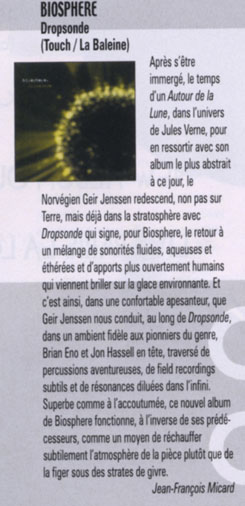
The Sunday Times (UK):

The List (UK):

Foxydigitalis (USA):
Biosphere is already a legend in the genre of ambient techno/electronica and his numerous albums are considered to be genre-defining by many. Still, his music has never sounded overly exciting to me and that hasn´t changed with the release of “Dropsonde.” After its initial LP-only release, it is now available on CD in the typical impeccable Touch design with photos by Jon Wozencroft and some extra tracks.
Because Geir Jenssen a.k.a. Bioshphere lives in the far north of Norway, “arctic” is a standard synonym to describe his music. In comparison to some of his previous work, “Dropsonde” is much warmer in feel though. The introductory “Dissolving Clouds” marks a hopeful beginning of the disc with its shimmering sine wave sounds. What follows is a variety of two different types of tracks. Several tunes combine sampled jazz beats with dancing hi-hats with the standard digital arsenal of looped organs, strings, etc. These tracks are not unpleasant at all, but they have been heard in one or the other variation many times over the last seven or eight years. Also, tracks like “Fall In Fall Out” or “Birds Fly By Flapping Their Wings” show such little variation that they get boring quickly. In a way they sound like sketches streched to fit the standard “five minutes plus” format of ambient techno. Only on “Daphnis 26”, Biosphere shows his real capabilites in the above described first category of tunes on this disc. The drum samples are more tribal and the track is developing in an energetic way.
Apart from “Daphnis 26”, beatless songs are Jenssen´s real strength. The slowly morphing “From a Solid to a Liquid” is a beautiful and soothing piece of dreamy ambience. So are “Warmed By the Drift” and “People Are Friends”, which feature the more somber aura, Biosphere is known for. Biosphere fans – and I know there a lot of them out there – will be happy to hear that the CD version is half an hour longer than the LP version. For me though, 70 minutes are just too long when there are only four or five tracks that are interesting enough to disrupt me from my daily ongoings. [Stephan Bauer]
Ikonen (Germany):
Der norwegische Musiker Geir Jenssen hat mit seinem Projekt Biosphere seit Jahren eine eigene Liga der Ambientmusik eröffnet: Immer weiter treibt er seine mitunter kühlen, düsteren, aber stets originellen Erkundungen der nördlichen Landschaft. “Dropsonde” – benannt nach Wettersonden, die in der äußeren Hemisphäre abgeworfen werden – erringt mit leichter Hand jazzige Sphären, ohne den faszinierenden Soundscape-Charakter zu verraten, der Stücke wie”Novelty Waves” zu weltweiten Hits werden ließ. Bediente sich Jenssen früher oft technoider Strukturen, vertraut er seit “Substrata” auch auf minimalistische Flächen, die sich nur langsam aus der Firnis lösen.
Anders als seine Kollegen vom erdigen Darkambient-Fach tendieren die Biosphere-Kompositionen nicht zur Erstarrung. Sie befreien sich schichtweise von ihrer Kruste, um in luftigere Höhen aufzubrechen, zu denen sie von flirrenden Miles-Davis-Beats getragen werden. Doch hinter dieser Leichtigkeit lauert erneut das Unbekannte. Erst mehrere Dimensionen müssen erschlossen werden, um die volle Tiefe dieses Werkes zu offenbaren. Stimmen wurden laut, die hier das reifste und aufregendste Album von Biosphere vermuten, und tatsächlich suchen die 11 kubistischen Klangskulpturen ihresgleichen – “Dropsonde” lullt ein, spornt an, irritiert und verstört, wie man es von einer Ambientsinfonie nur erwarten kann. Die Titel bleiben dabei assoziativ und rätselhaft: “Warmed by the Drift”, “From a Solid to a Liquid”, “Daphnis 26”, “Sheerbroke” usw. Die stilvolle Umschlaggestaltung bietet dazu Detailaufnahmen von Blüten in verfremdeten Farben.
Wer glaubt, Ambientmusik habe mit Brian Eno bereits vor 20 Jahren ihre Möglichkeiten erschöpft, sollte sich dringend “Dropsonde” besorgen, ein eigenes Kapitel in der Geschichte des Klangkunstprojekts Biosphere wie auch der ambienten elektronischen Musik allgemein – ein Meisterwerk. [Marcus Stiglegger]
Dusted (USA):
At work above the Artic Circle for around 15 years, Biosphere’s last few records have shown Norwegian Geir Jenssen using subtle conceptual tweaks to build upon the landmark gossamer style he came close to perfecting with 1997’s Substrata. While Shenzou’s Debussy reworkings and Autour de la Lune’s mining of a French radio play based on Jules Verne’s De la Terre à la Lune provided welcome abstractions, there’s a certain unwanted heavy-hand that settles over Dropsonde’s approach of modal jazz structures and appended percussion. Whereas Jenssen had previously allowed his instrumental loops, samples and gauzy textures to traffic in hints and innuendos, here they become overstated and bluntly obvious. Melody is the focus, and while that’s not necessarily a bad thing, this emphasis forces the loss of some of the brilliant sheen that made his other records so intoxicating.
Originally released as a six-song LP, the CD version of Dropsonde doubles the length of the vinyl and still manages to omit one track from the original release. The major problem here comes from the added percussion. While not affixed to every track, Jenssen’s sampled drum loops sound as if they were stapled to his pieces as a mere afterthought, and generally his rhythmic counterpoints lack variation throughout the course of his tracks. Previously cadences were implied, but here they come front and center. This isn’t really bad, per se, and when the titular signature kicks on “In Triple Time,” the effect is actually quite sublime. But there wasn’t much of a need to muddy up the birdsong recordings on “Birds Fly by Flapping Their Wings” with generic drum patterns when his typical exegesis would have done just fine. Likewise, the pronounced blurps of “Altostratus” chafe a bit too much, while the harder loop of “Sherbrooke” sounds like an unwelcome return to the click + cut aesthetic.
There are patches of brilliance throughout Dropsonde, however, even with the added skins. “Daphnis 26” approaches Jan Jelinek-worthy loops by holding the percussive patterns at bay – they threaten to pulse hard, but Jenssen always manages to pull back on the reins. For those seeking a return to his earlier highlights, “From a Solid to a Liquid” capably soundtracks transference to melodic whisps, while “Warmed by the Drift” glacially stretches string tones to an effect that almost sounds like bowed ice blocks.
Ultimately, it would be horribly unfair to fault Geir Jenssen for attempting to reach outside of his soundworld in a manner such as this. After all, a lack of variation has undone quite a few musicians who haven’t been going for nearly as long. However, much of the Biosphere catalogue earned repeated spins because multiple listens were necessary to fully grasp the intricacies of Jenssen’s work. Here, the emphasis on modal structures reveals too much too quickly, and the loss of the subtle makes the album just a bit forgettable. Still, it shows that Geir has plenty of tricks up his sleeve even after a decade and a half of work. Whatever comes next will undoubtedly still be worth a listen. [Michael Crumsho]
Signal To Noise (USA):
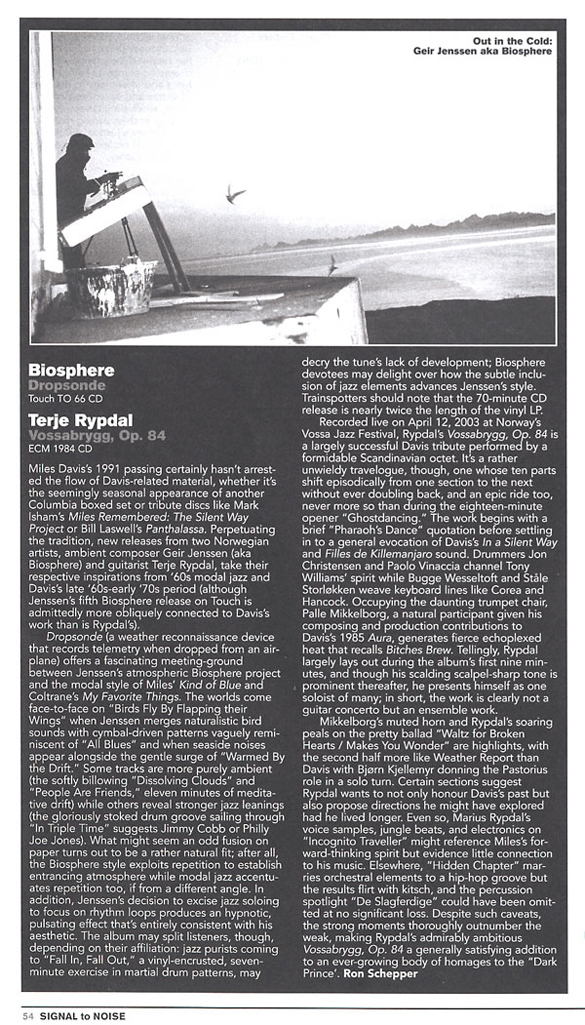
BerlinXS (Germany):

Spex (Germany):

Westzeit (Germany):

His Voice (CZ)::
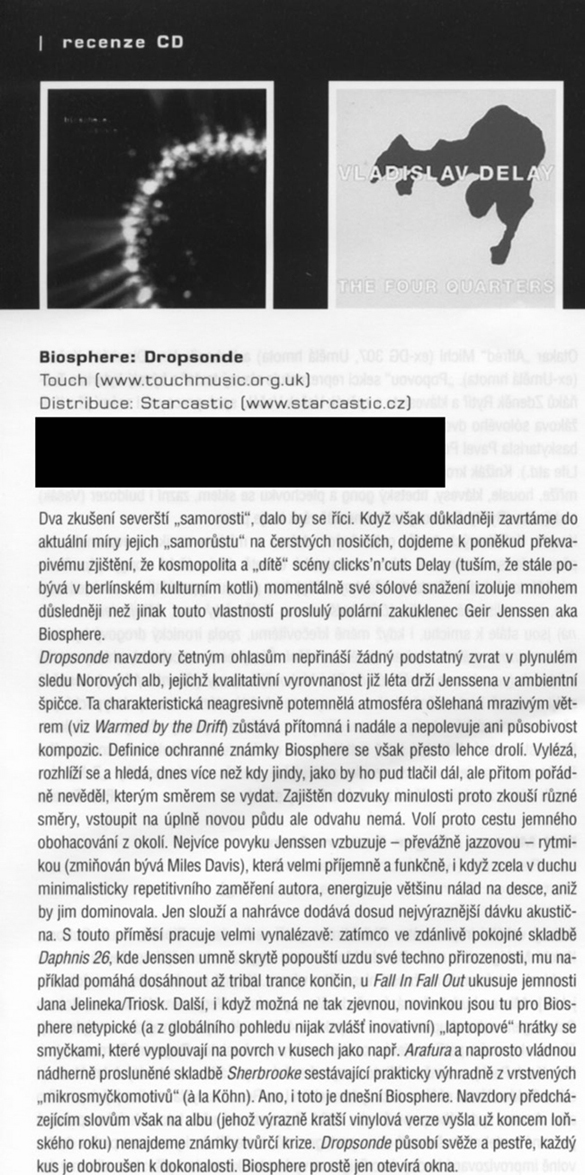
Classic FM (UK):
#Welcome to the Chiller Cabinet Playlist Email#
EVERY SATURDAY & SUNDAY 2 – 4 am
1 0 0 ~ 1 0 2 fm
A two hour mix of ambience, movies, & minimalism.
—————————————————————
SATURDAY 8 APRIL
FEATURED ALBUM – DROPSONDE
BIOSPHERE is Norwegian composer and performer Geir Jenssen. You may
recognise his work without knowing it, so frequently does it crop up on
TV trailers and idents. As with all of the BIOSPHERE albums, the music
draws you in and makes you want to listen and feel. Jenssen’s work acts
on a very emotional level, one that encourages you to drift away into a
haze of images and scenes brought to you by the music.
We thought it was worth mentioning BIOSPHERE is touring UK Picture
Houses from the 19th to the 23rd April (www.picturehouses.co.uk)
Wednesday 19th April, LONDON, Gate Cinema (Notting Hill) Thursday 20th
April, LIVERPOOL, Picturehouse at FACT Friday 21st April, LONDON,
Greenwich Picture House Saturday 22nd April, LONDON, Ritzy (Brixton)
Sunday 23rd April, BRIGHTON, Duke Of Yorks Picturehouse
|1|Biosphere|Altostratus|5:11|
|2|Chanticleer|Grace to you|5:43|
|3|Boards of Canada|Tears from the Compound Eye|4:03|
|4|Colleen|the happy sea|3:00|
|5|David Gordon / Henry Purcell|Hocus Pocus|2:44|
|6|Biosphere|From a solid to a liquid|5:19|
|7|King Creosote|KC Vice Like Gist Of It – Jon Hopkins
Dub Remix|4:22|
|8|Amon Tobin|Theme from Battery|4:28|
|9|Thomas Newman|Permission to Fire|4:54|
|10|Biosphere|Dissolving Clouds|4:28|
|11|Ted Barnes|In the Shed|4:30|
|12|David Gordon / Henry Purcell|Music for a While|3:52|
|13|Colleen|Everyone Alive Wants Answers|3:27|
|14|ISAN|Gymnopedie 2|1:57|
|15|Iris Garrelfs|encounter 7|4:49|
HOUR 2
|16|Arvo Part|Fur Alina|10:36|
|17|Alex Heffes & Kawesa|The Question|3:25|
|18|Chanticleer|In Winter’s Keeping|8:44|
|19|Angelo Badalamenti|Country Theme|3:37|
|20|Aoki Takamasa/Tujiko Noriko|fly2|2:51|
|21|Biosphere|People are Friends|10:39|
|22|Colleen|bubbles which on the water swim|3:11|
|23|John Barry|Okay Dad; Mother Shut Up!|2:52|
|24|Colleen|the golden morning breaks|5:22|
|25|Biosphere|Warmed by the drift|6:50|
Homework:
www.biosphere.no
myspace.com/biospheregeirjenssen
www.touch33.net
Beam Me Up (DE):
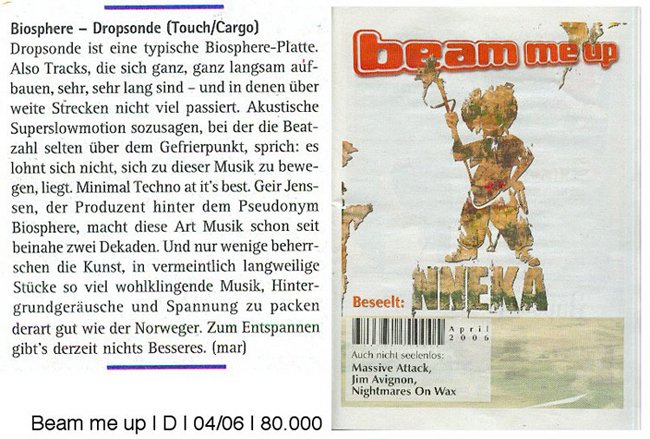
infratunes.com (France):
La musique de Geir Jenssen s’est toujours caractérisée par une relation de transparence absolue entre le paysage et les constructions sonores. C’est justement cette transparence, cette limpidité qui a permis à cette musique d’échapper à l’écueil de la bande-son pour film imaginaire ou paysage boréal – contrairement aux clichés les plus tenaces qui courent sur Biosphere. Ici une batterie récurrente et particulièrement attachées aux rythmes ternaires et aux cymbales prodigue quelque ouverture vers une rythmique jazz, un swing discret.
Oui, la musique de Biosphere est immersive mais elle n’est ni visuelle, ni descriptive. Elle est plutôt le vecteur souple d’atmosphères qui ne sauraient exister autrement que sous la forme très particulière de cette musique que l’on qualifiera d’ambient par facilité, mais qui est toujours en excès face à ce qu’entend proposer l’ambient.
Si elle doit être rattachée à une expérience concrète de l’espace, la musique de Biosphere porte la trace des lieux où elle est née plus qu’elle n’est transcription musicale de ces lieux. Cette distinction est importante, qui rappelle que la musique n’est pas secondaire, comme un pont vers l’image, mais qu’elle est ici toujours première et dernière.
Les titres, qui font office de notes de pochette et d’intention tant ils sont clairs, semblent à chaque fois décrire un phénomène atmosphérique ou naturel – moins parce qu’il a été observé que parce que la musique est née à l’intérieur de celui-ci. La musique de Biosphere est ainsi faite qu’elle porte toujours une attention infinie à ces conditions de possibilité, à l’espace, à la durée, au lieu et au temps qui la voient naître. Et si les compositions de Dropsonde ne portent pas toujours la singularité des productions précédentes de Biosphere, si leur pouvoir d’envoûtement leur fait parfois défaut, soyons certains au moins que cet album poursuit l’art unique que s’est inventé Geir Jenssen. [Johnny One Shot]
Orkus (Germany):
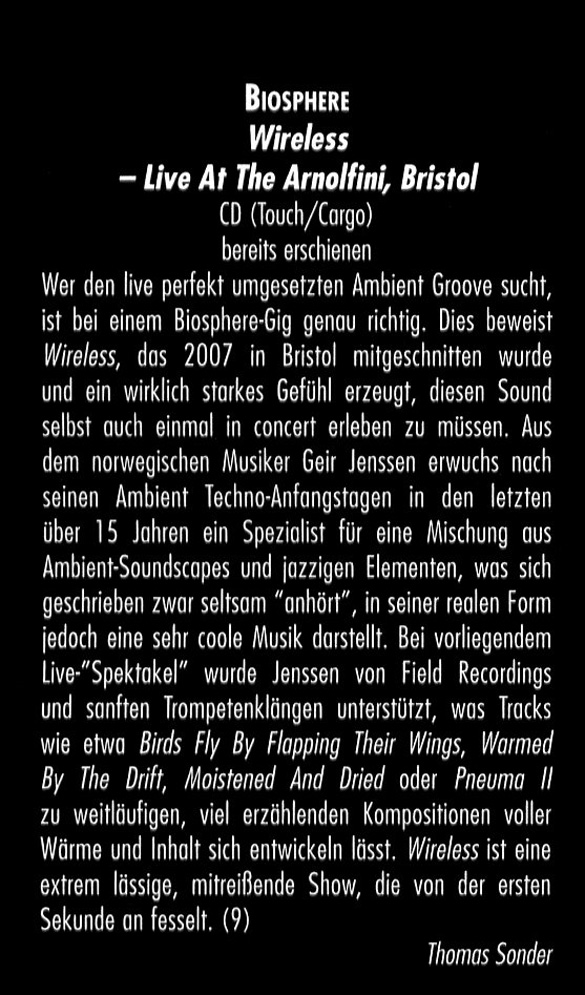
Bad Alchemy (Germany):
Wie Ambient und Environmental Music die Untiefen bloßer New-Age-Beschallung umschiffen kann, zeigte der Norweger Geir Jenssen immer wieder durch die subtile ‚nordische‘ Atmosphäre seiner Klangbilder mit ihrer Anmutung von Schnee, Eis und dünn besiedelten Landstrichen, die sich unter der Mitternachtssonne nicht mehr sehr unterscheiden von den kalten, sternklaren Leer- und Dunkelräumen hinter dem Mond, zu dem er mit Autour de la Lune gereist war. Hier zieht er bei ‚Birds Fly By Flapping Their Wings‘ ganz andere Register mit einem rhythmischen Swing aus jazzigen Loops. Hihattickling, Kontrabass und ein Keyboardriff kreisen in sich selbst und das gibt auch bei ‚In Triple Time‘ und ‚Arafura‘ einen je monoton mäandernden, aber doch in sich sanft bebenden Kammerflimmer-Kollektief-Touch, zu dem manchmal Hunde bellen, was den Unterschied von Drinnen und Draußen noch unterstreicht. Die Natur bleibt als Horizont präsent – ‚Dissolving Clouds‘, ‚Warmed by the Drift‘ -, aber die Klänge suchen einen Weg, Festes zu schmelzen (‚From a Solid to a Liquid‘) und Wärme auszustrahlen. Die Musik bohrt wie eine Wettersonde durch die Schichten des Gemüts und misst unterwegs die Temperatur. Musik, so cool wie schwarzer Samt, die aber doch einen Hang zu Zwielicht und Tristesse nicht ganz verleugnen kann, zu halbdämmrigen Gedankenfluchten, aus denen man durch den Marschtrommelloop und Herzschlagbass von ‚Fall in Fall out‘ genötigt wird, den Blick wieder zu heben und um sich zu schauen, während ‚Daphnis 26‘ den Puls mit einem federnden und dann sogar fiebrig anziehenden Unterton noch weiter beschleunigt. ‚Altostratus‘ bringt ein vertikales Moment ins Spiel, ein melodiöses Funksignal mit gemütlichem SF-Anstrich, und ‚Sherbrooke‘ einen automatenhaften Headbangerbeat zu wolkig geflocktem Keyboardgekräußel. Das finale ‚People Are Friends‘ (husthust – Entschuldigung) nimmt sich noch einmal gut 10 Minuten Zeit, um vor dunkel dröhnendem Hintergrund wie blind nach einer Melodie zu tasten, während eine Frauenstimme geisterhaft wispert: „I want to stay.“ [Rigobert Dittmann]
Groove (Germany):
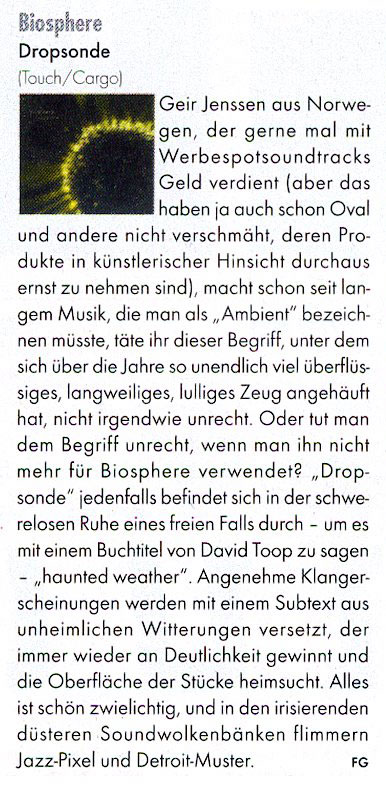
Music Scan (Germany):
Eine neues Biosphere Album bringt aufgrund der grazilen Schönheit eines Großteils der Vorgänger eine gewisse Erwartungshaltung mit sich. Diese kann Geir Jenssen jedoch auch auf “Dropsonde” wieder ganz mühelos entkräften, denn nach dem etwas wirren und bemüht eklektizistischen “Autour De La Lune” besinnt man sich wieder auf die minimalistischen Stärken, die Alben wie “Microgravity” oder “Substrata” zu unentbehrlichen Bestandteilen einer jeden Electronica und Ambient Sammlung gemacht haben. Die leidige und auch reichlich hilflosen Bezüge zum Wohnort Jenssens 500 km nördlich des Polarkreises müssen hier nicht mehr in die Deutung der Musik einbezogen werden, denn diese steht seit vielen Jahren für sich, ohne auf regionale oder geographische Verortungen bauen zu müssen. Auf “Dropsonde” verbindet sich eine schier unermüdlicher Puls mit fein flirrenden Harmonien und hauchdünnen musikalischen Schichtungen, die nur auf den ersten Blick stillzustehen scheinen, denn wenn man genauer hinhört, ist hier fast alles ständig in Bewegung. Diese Bewegungen sind bei Biosphere jedoch subtil, ja fast minimal und deshalb kann es auch schon mal etwas länger dauern, bis sich ein Track zu etwas entwickelt, das man mit gutem gewissen auch so nennen kann. Die dichten Atmosphären sind sowohl beruhigend und warm als auch bedrohlich und düster und können ganz unvermittelt und ohne irgendwelche großen Gesten ins Gegenteil umschlagen. Dieses gegenseitige Wechselspiel oder Abhängigkeitsverhältnis von Leichtigkeit und Schwere, und die Art wie Geir Jenssen damit umgeht, ist das eigentlich Faszinierende an Biosphere, denn kaum jemand sonst versteht es, einen so spannenden und geschmackvollen Mittelweg zwischen diesen Extremen zu gehen. Ich bin sicher, wir werden noch mehr zu hören bekommen und darauf darf man sich schon jetzt freuen. 8.5/10 [Matthias]
solenoide (France):
Voilà plus de 15 ans que Geir Jennsen arpente les vallées froides de l’ambient electronica. Quinze années d’une emprise discrète sur le pôle le plus avancé des musiques électro-climatiques. Un bail plutôt long – à l’échelle de la technosphère – à l’égard duquel cet album tient lieu d’accord tacite de renouvellement.
Flirtant d’abord avec les ambitions du dancefloor mental avant de se soumettre aux exigences de l’art contemporain, Biosphere a toujours su évoluer par paliers sans jamais nier sa fascination pour l’environnement polaire, les paysages nocturnes ou encore l’observation céleste. C’est dans ce dernier vivier thématique, mais aussi sous la forme d’un retour vers des territoires sonores plus hospitaliers, qu’opère “Dropsonde”. Un album basé sur la superposition de boucles, de nappes et autres tintements sophistiqués, qui s’enrichit sur quelques titres de samples à connotation jazz marquant une parenté avec les montages cyberjazz du Innerzone Orchestra (de Carl Craig). Possible synthèse des travaux antérieurs de Biosphere, “Dropsonde” trouve le point d’équilibre et de tension idéal entre nébulosité froide et chaleur anxieuse. Constellés de détails riches et évocateurs, associant matériaux organiques et traitements cliniques, les 11 pièces de ce disque dérivent dans notre imaginaire comme autant de sondes en apesanteur, autant de sondes audio-numériques que les amateurs de minimalisme extatique s’approprieront avec bonheur.
Au bout du compte, “Dropsonde” se révèle être l’album le plus entêtant de Biosphere, celui qui relie magistralement les notions d’abstraction et de contemplation. Un album qui, en s’appuyant sur la plus large palette de textures, d’échantillons et de rythmes jamais utilisés par l’artiste, conforte sa position de paysagiste phare des musiques digitales.
Black (Germany):

030 (Germany):
Wenn es um atmosphärisch verdichteten elektronischen Wohlklang geht, ist Geir Jennsen aka Biosphere schon seit Jahren allererste Adresse. Er lässt es zwar immer wieder auf ähnliche Weise blubbern, aber er versteht etwas davon, seine Klangwölkchen mal nach Sonnenschein, mal nach Regen aussehen zu lassen und ist ein echter Meister darin, Stimmungen akustisch einzufangen. Licht aus, Musik an, Füße hoch und sich wegdriften lassen, so lautet die Bedienungsanleitung für diese Platte.
Skug (Austria):
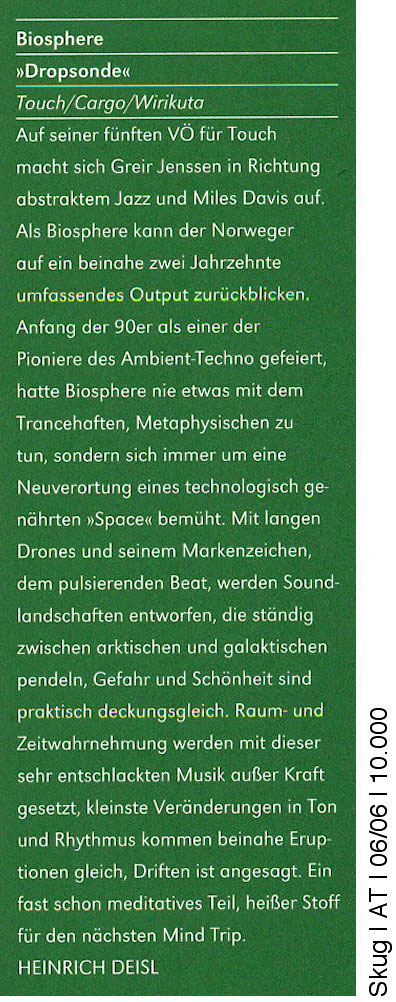
BigLoad (Germany):
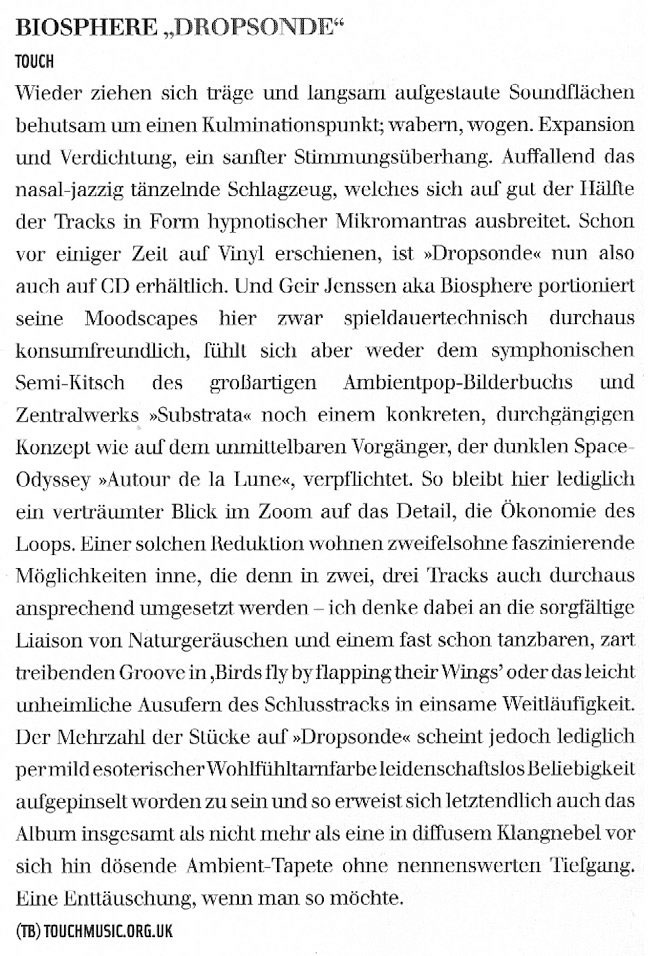
Playboy (Poland):
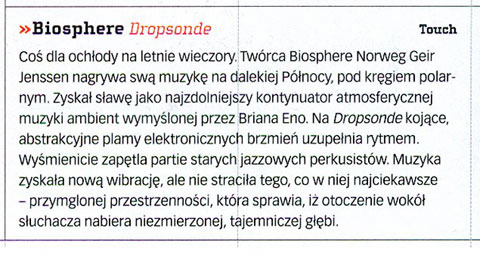
Fear Drop (France):
Il arrive que le glacier dépose quelque récompense qu’il a longtemps roulée et érodée dans ses fonds, ses fonds rêches et sombres comme l’inconscient. Polis, les galets, les éclats, montrent beaucoup de sérénité, sans d’autre trace de l’effort séculaire qui les a émoussés que l’annulation de leur tranchant. Il y a quelques années, au début de la carrière solo de Geir Jenssen sous le nom de Biosphere, il avait formé le projet d’une musique rythmée et électronique assumant ses déhanchements dans un environnement glacé, la froide lumière du néon. Peu à peu, les boucles, les tissages se sont allongés, pour prendre les tournures fantasmées d’une musique arctique semée d’éclats, jusqu’à l’abstraction könerienne de Autour de la lune. Après ce passage dans les glaces, Jenssen, comme passé de l’autre côté du pôle, entame sa descente vers des zones plus tempérées. Les neiges fondent, les pierres qu’elles ont roulées et les moraines qu’elles ont creusées gardent l’empreinte d’anciens mouvements que la zone hyperboréenne a transformés. Les sons de cymbales, les contrebasses, jusqu’à des roulements de caisse claire !, sont les nouvelles références rythmiques que Jenssen a héritées de certaines de ses écoutes (Miles Davis, Jon Hassell), filtrées par le souffle du froid et de la brume tout en nuances d’aurore boréale. Dropsonde est la traduction de cette progression, la renaissance à la lumière de gestes et d’articulations qui ont été marquées à jamais par le froid. Le parti pris est presque acoustique, concernant les fragments rythmiques, les percussions et les basses, comme lors d’une recréation virtuelle d’un orchestre jazz. A cela s’ajoutent les vagues de lumière, les multiples étincelles sur la glace qui fond, des irisations. La mélodie est là, qui ne peut que s’engraisser dans pareil terreau. Loin de la pesanteur, ces odes à la souplesse se déroulent en défiant les lois physiques tout autant que les conventions électro ou acoustiques qu’elles mêlent. L’une, fausse chaleur – dont les vagues ont le pli courbé, la finition en coupole – : le relief percussif dénonce son artificialité dans la boucle. L’autre, électronique chauffée : la réverbération synthétique s’incruste de mille éclats métalliques lancés par les cymbales. Les morceaux centraux de l’album, In triple time, From a solid to a liquid et Arafura, sont de ce point de vue exemplaires d’équilibre.
Geir Jenssen a accompli un acte très simple et en même temps presque irréalisable. Il a filmé la naissance de la lumière. Son ballon météo (Dropsonde) capte et rend compte de cette éclosion qui s’apparente à d’autres transformations qu’atmosphériques, à une métamorphose, à la mise au jour d’un organisme musical qui a longuement mûri ses appendices mélodiques et rythmiques dans son cocon de froid. [Denis Boyer]
Sound of Music (Sweden):
Första gången jag hörde ambient musik var jag sexton år gammal, gick på gymnasiet och lyssnade mestadels på band som Stereolab, Boards of Canada och en del Björk. Jag kommer tydligt ihåg hur jag av ren slump råkat ladda ned en låt med en snubbe som kallade sig Biosphere, låten hette ”The Silent Orchestra” och var bland det skummaste jag hört. Det var för mig då ganska oklart varför jag inte kunde sluta lyssna på låten, den hade ju ingen melodi som fastnade på hjärnan eller någon text man kunde gå runt att sjunga på.
Idag börjar jag nog förstå varför ”The Silent Orchestra” är en sådan låt som jag inte bara lyssnade väldigt mycket på utan även började bygga ut mitt hela musikintresse kring. För efter upptäckten av Biosphere följde en utforskning av den ambienta musikkonsten jag sporadiskt arbetar med även nu för tiden. Och det är nog tack vare de upptäckter jag gjort jag lärt mig förstå vad det är som är så fascinerande och fängslande med musik som Biospheres. Det hela har med att göra en form av aktivt lyssnande. Ambient (och även andra former av experimentell musik) lämnar nämligen något upp till lyssnaren, en slags öppenhet för reaktion eller kanske mer ett tvång till reaktion, men istället för att väcka denna reaktion genom en till exempel en textbaserad historia gör ambient musik detta genom rent känsloförmedlande. För på något sätt känns det faktiskt som den bäst passande beskrivningen av experimentell musik, känsloförmedlande.
Biosphere heter egentligen Geir Jenssen och kommer från Tromsö, Norge. Innan Geir började göra musik med sitt Biosphere-projekt spelade han i det Cocteau Twins-influerade bandet Bel Canto. Han har under tiden han arbetat som Biosphere haft en rad sidoprojekt men med jämna mellanrum återvänt till sitt soloprojekt. I dagarna gjorde han det för tionde gången när han gav ut sin senaste skiva ”Dropsonde”.
Jag har under de få år jag levt med Biospheres musik hunnit bli besviken ett flertal gånger, när och varför har varierat men det har inte bara handlat om hans nyare skivor. Ifjol kom till exempel den väldigt underskattade ”Shenzhou” och än en gång var jag en glad beundrare av Geir Jenssens musik. Det hjälpte även till att öka exaltationen över hans senaste släpp. ”Dropsonde” är dock emellertid mer av en besvikelse än en vacker fortsättning på ”Shenzhou”. Bland annat har Geir valt att bygga skivan runt jazz-slingor, något som rent spontant kanske känns som en intressant idé men som i praktiken bara blir att låta som ett tröttsamt Kammerflimmer Kollektief. Det enda som känns bra med att ”Dropsonde” inte lever upp till förväntningarna är att man vet att Biosphere snart är tillbaka med en skiva som placerar honom back on top, under tiden kan man till e
electronique (Italy):
9/10
A caduta libera, ma non in cerca di uno schianto. “Dropsonde” (2005) di Biosphere prende spunto dal dispositivo progettato dal National Center For Atmospheric Research (NCAR) del Colorado per raccogliere dati termodinamici attraverso sensori. La sonda, dotata di paracadute, trasmette via radio quanto si verifica nel cuore pulsante, ad esempio, di una tempesta tropicale.
Non necessita di particolari presentazioni Geir Jenssen, annoverato di diritto tra i pionieri della musica ambient contemporanea. In “Dropsonde” si è divertito a volare a modo suo, inseguendo strati di suono e valicando i confini della delicata copertina opera di Jon Wozencroft, il fondatore della Touch. Oltre l’aria, quel che resta è musica. Elettrica.
L’apertura del lato A è straordinaria. Frammenti field recordings come base per un’accennata intro, poi batteria in loop, accenni drone e note di tastiera ridotta al minimo: è la formula vincente. Il ritmo di Birds Fly By Flapping Their Wings è ipnotico, a tratti meditativo, ma soprattutto vivo, una sorta di sperimentale mix ad alta quota tra minimalismo e jazz d’altri tempi.
Le calde tonalità dei colori sfumano rapidamente quando subentra Fall In, Fall Out, costruita con una base di crepitii catturati da dischi in vinile, puri glitch digitali e un rullante marziale che scandisce il tempo. Un altrettanto incalzante drumming, tanto magnetico quanto tribale oltre la metà della traccia, diviene l’epicentro di Daphnis 26.
Per l’ennesima volta, Biosphere esibisce insolite capacità compositive, destinate poi essere a messe in mostra anche nel successivo “N-Plants” (2011). Il norvegese, con alle spalle una lunga carriera, conferma così la sua personale deriva verso altre sonorità, in apparenza distanti da quelle algide degli esordi, ma simili in termini di architetture, schiette e sghembe.
Registrazioni dal vivo sulla cima del monte Cho Oyu, al confine tra Cina e Nepal, iterazioni siderali ideali per appagare diversi stati d’animo e incursioni fusion capaci di evocare il Miles Davis dei primi anni Settanta: all’ottavo album non arriva mai tardo il momento in cui è necessario osare, reinventando sé stessi e ridefinendo il proprio agire in studio.
Il lato B è, infatti, maggiormente orientato sul fronte downtempo, da esplorare con curiosità. Ad esempio, Altostratus sembra un ammasso organico di pulsioni tutte elettroniche, cinematiche, incerte, timide come lo scorrere di una nuvola passeggera nel buio della notte; mentre Sherbrooke la squarcia in un istante attraverso uno sciame di lucide ripetizioni.
Gli ultimi sei minuti sono, infine, propri di un’esclusiva della versione vinile dell’album, in seguito pubblicato anche in formato cd con ulteriori sei corposi brani. In The Shape Of A Flute segna, invece, il ritorno al vibrante approccio iniziale, con flauti e trombe come nuovi elementi di rinforzo, utili nel segmentare al meglio un’atmosfera ai confini dell’onirico. [Marco Ferretti]










